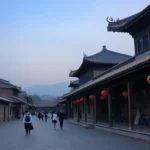Cultural Clashes in the Pantanal Region

Have you ever found yourself in a situation where you simply can't believe what you're seeing? Traveling often presents us with these incredible moments of cultural shock that leave us both bewildered and fascinated. As we explore new places, we gather experiences that challenge our perceptions and broaden our understanding of the world around us. There is so much more to learn and appreciate about the diverse customs and practices that exist globally.
In this article, we delve into one of the most intriguing instances of cultural clash: the "pantañal" or "pantaguero" phenomenon in China. This unique practice highlights the stark differences in cultural norms and child-rearing methods. So let’s explore this captivating aspect of travel that showcases how our differences can spark curiosity and learning.
What is the "pantañal" cultural phenomenon?
The term "pantañal" refers to a specific style of children's clothing predominantly seen in China, characterized by pants that feature an open area at the back. This allows children to relieve themselves wherever they may be, rather than being confined to the limitations of traditional diapers. It's a practice that may seem surprising to many outside of China, but it illustrates a different approach to parenting and child hygiene.
In essence, the pantañal embodies a cultural mindset that prioritizes freedom and convenience. Parents in China often perceive this method as economical and practical, as it eliminates the need for diapers. This practice reflects broader societal attitudes towards waste management and environmental consciousness, showcasing how cultural norms shape everyday life.
Characteristics of the cultural shock experience
Experiencing cultural shock can manifest in various ways, often leaving travelers intrigued and puzzled. Here are some notable characteristics:
- Surprise: Encountering practices that differ drastically from one's own can evoke a sense of disbelief.
- Confusion: Cultural norms that seem illogical at first can lead to a misunderstanding of behaviors.
- Curiosity: These experiences often spark a desire to learn more about the culture in question.
- Reflection: Travelers may find themselves reflecting on their own cultural practices in light of new insights.
- Growth: Ultimately, these experiences can lead to personal growth and a broader worldview.
Benefits of cultural clashes in a society
While cultural shocks can be jarring, they also offer numerous advantages for individuals and societies. Here are some key benefits:
- Enhanced Understanding: Exposure to different cultural practices fosters empathy and understanding.
- Innovation: Cultural exchanges can inspire new ideas and creative solutions by blending diverse perspectives.
- Economic Growth: Cultural tourism can boost local economies as travelers seek authentic experiences.
- Social Cohesion: Engagement with diverse cultures can strengthen community bonds and promote tolerance.
- Preservation of Traditions: Increased interest in cultural practices can lead to their preservation and celebration.
How does the "pantañal" illustrate cultural differences?
The concept of the pantañal serves as a vivid example of the differences in parenting philosophies across cultures. In many Western societies, there is a strong emphasis on privacy and modesty, particularly when it comes to toilet training. Conversely, in China, the practice of allowing children to relieve themselves openly is seen as a natural part of life and child-rearing.
This practice can evoke a range of reactions from tourists, from amusement to discomfort. It challenges preconceived notions about childhood and hygiene, and forces observers to confront their own biases. Additionally, it raises important conversations about the varying definitions of cleanliness and practicality around the globe.
Understanding cultural practices through travel
Traveling provides a unique opportunity to witness cultural practices firsthand and engage with diverse communities. Here are some practical tips for approaching cultural differences while traveling:
- Stay Open-Minded: Embrace the differences you encounter and seek to understand them rather than judge.
- Ask Questions: Inquire about local customs and practices; most people appreciate your interest.
- Participate: Engage in local activities or traditions to gain firsthand experience.
- Reflect: Take time to think about how these experiences affect your views and beliefs.
- Share: Discuss your experiences with others to spread awareness and understanding.
Conclusion
The pantañal phenomenon is just one of many examples that illustrate the rich tapestry of cultural diversity around the world. As travelers, we have the privilege of learning from these encounters, which not only enrich our journeys but also deepen our understanding of the human experience. Each cultural shock presents an opportunity for growth, connection, and appreciation of the beautiful differences that make our world so vibrant.





Deja una respuesta